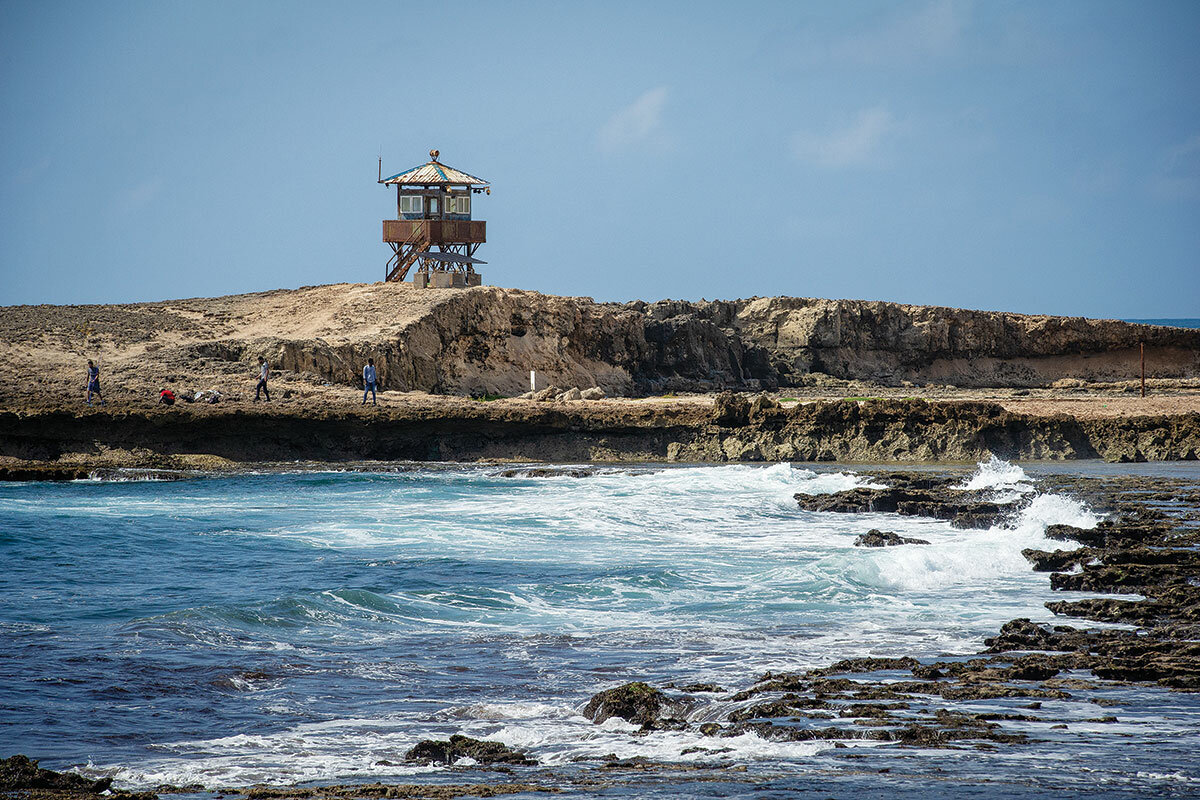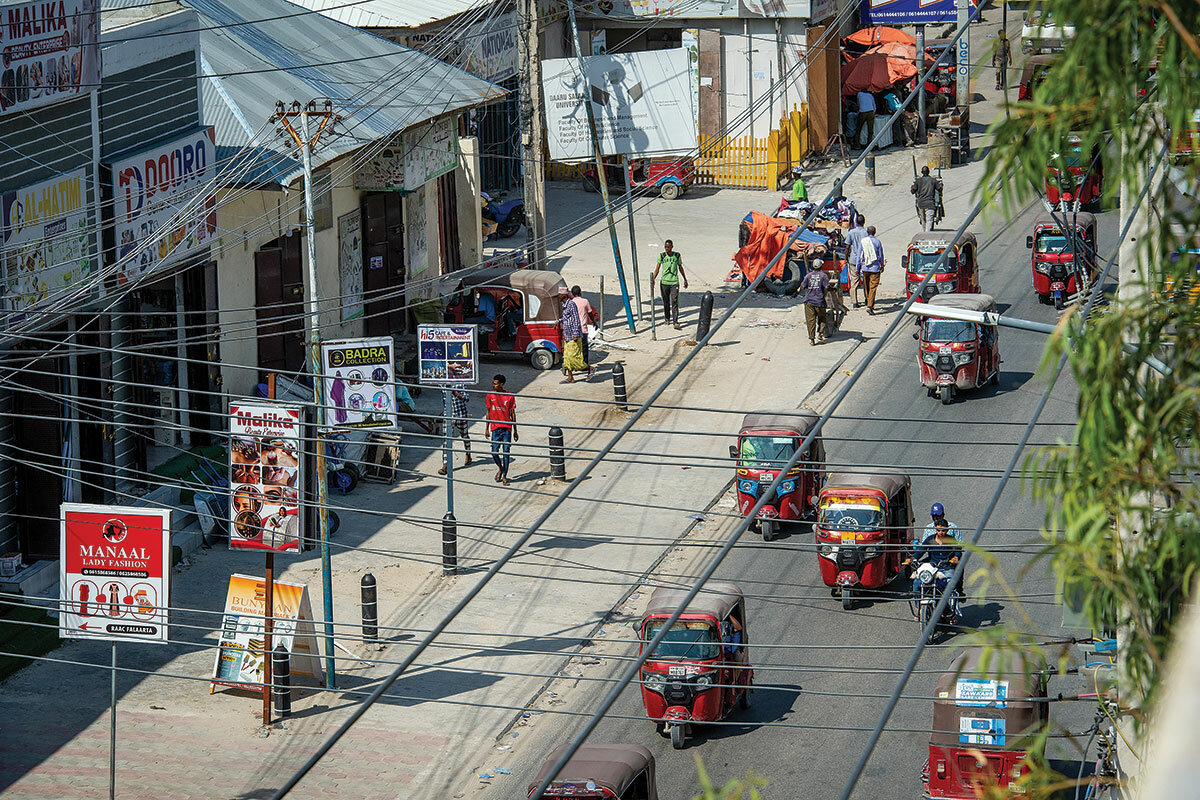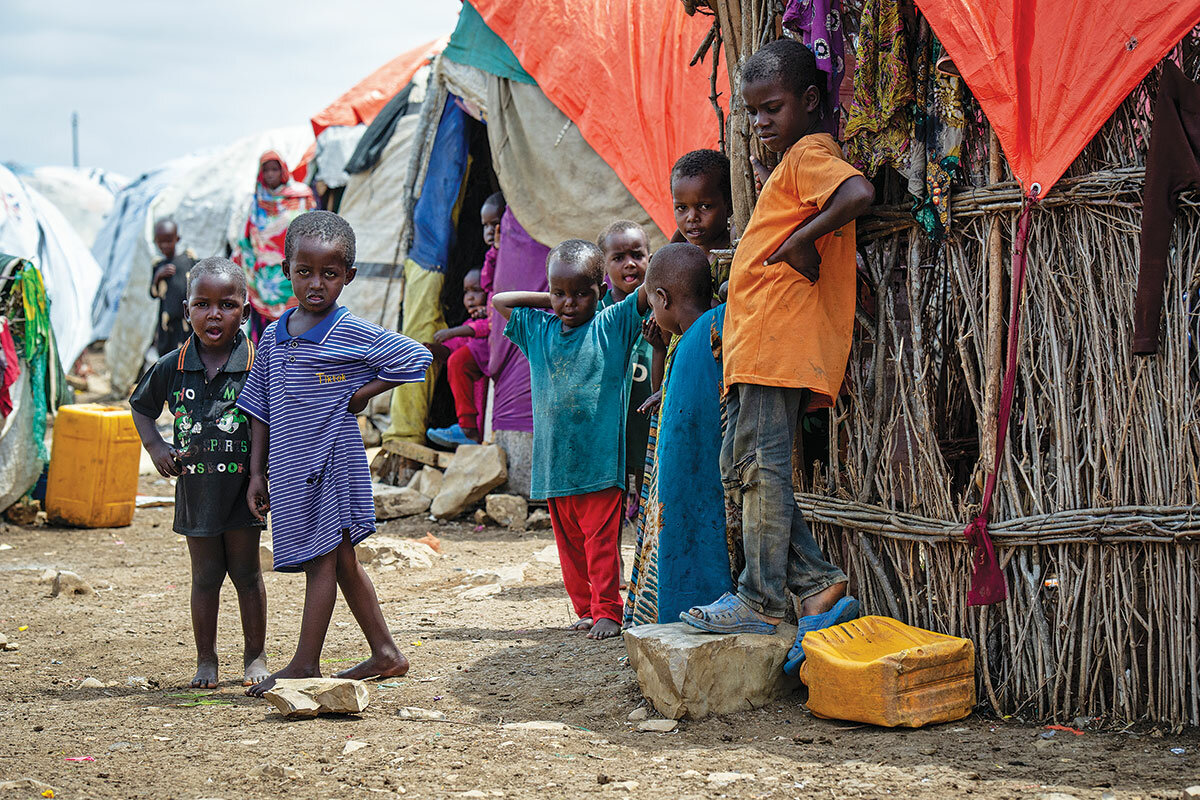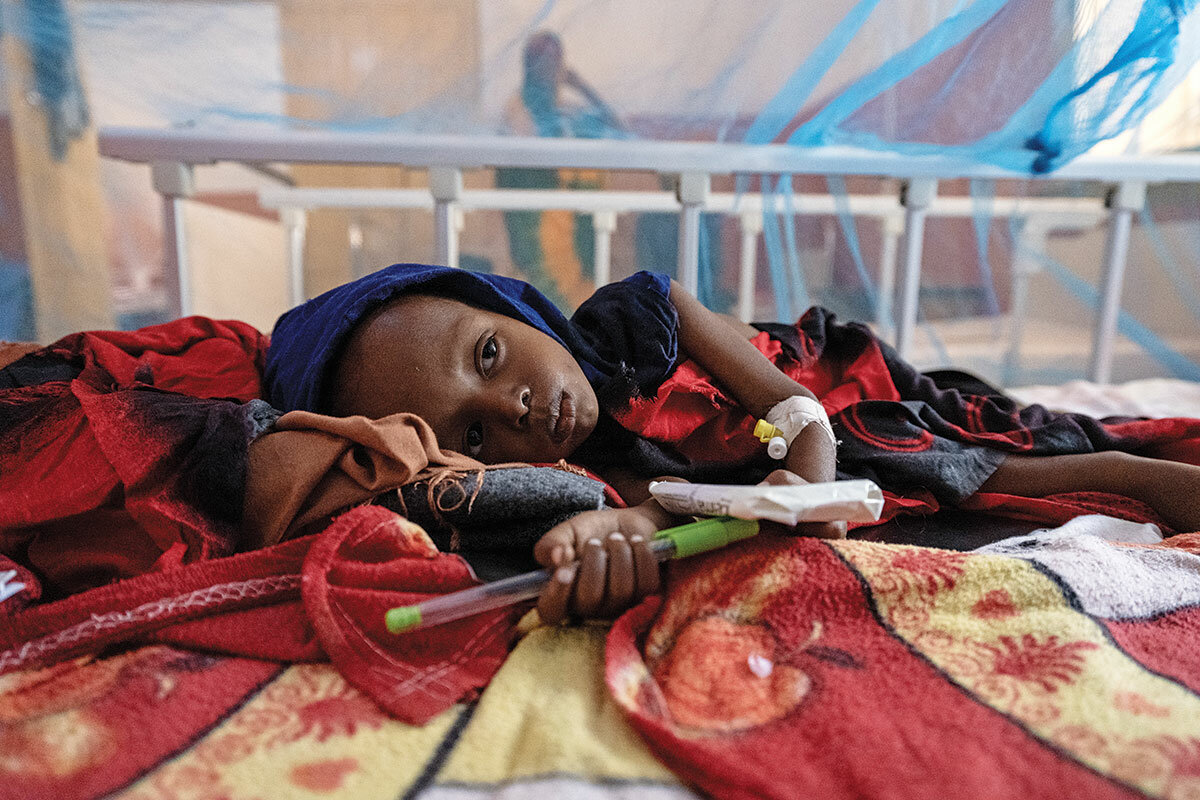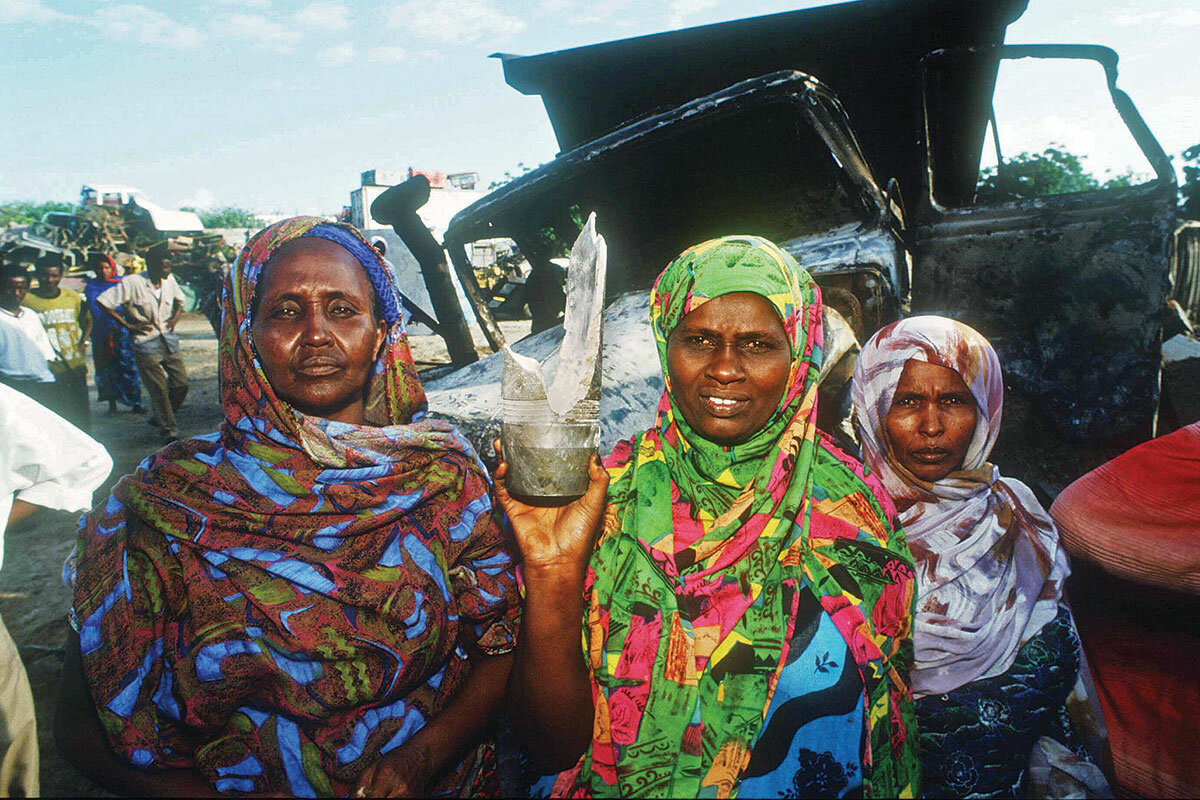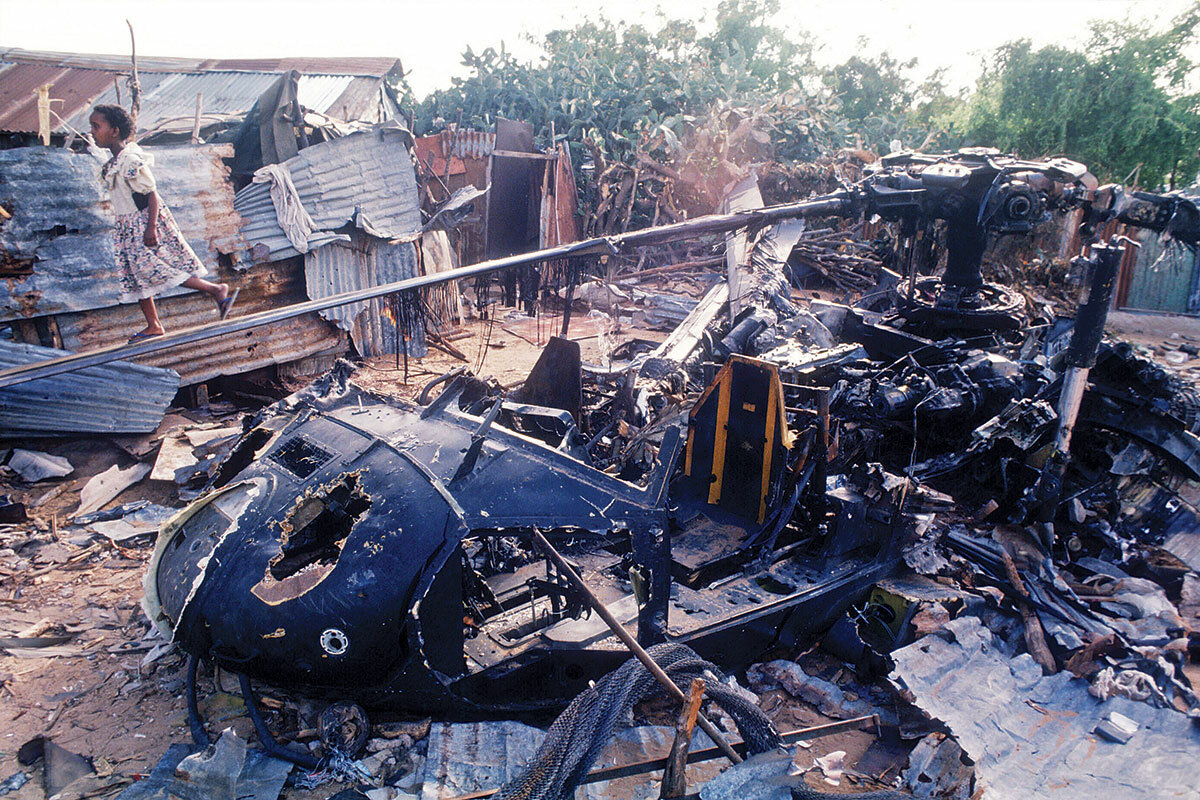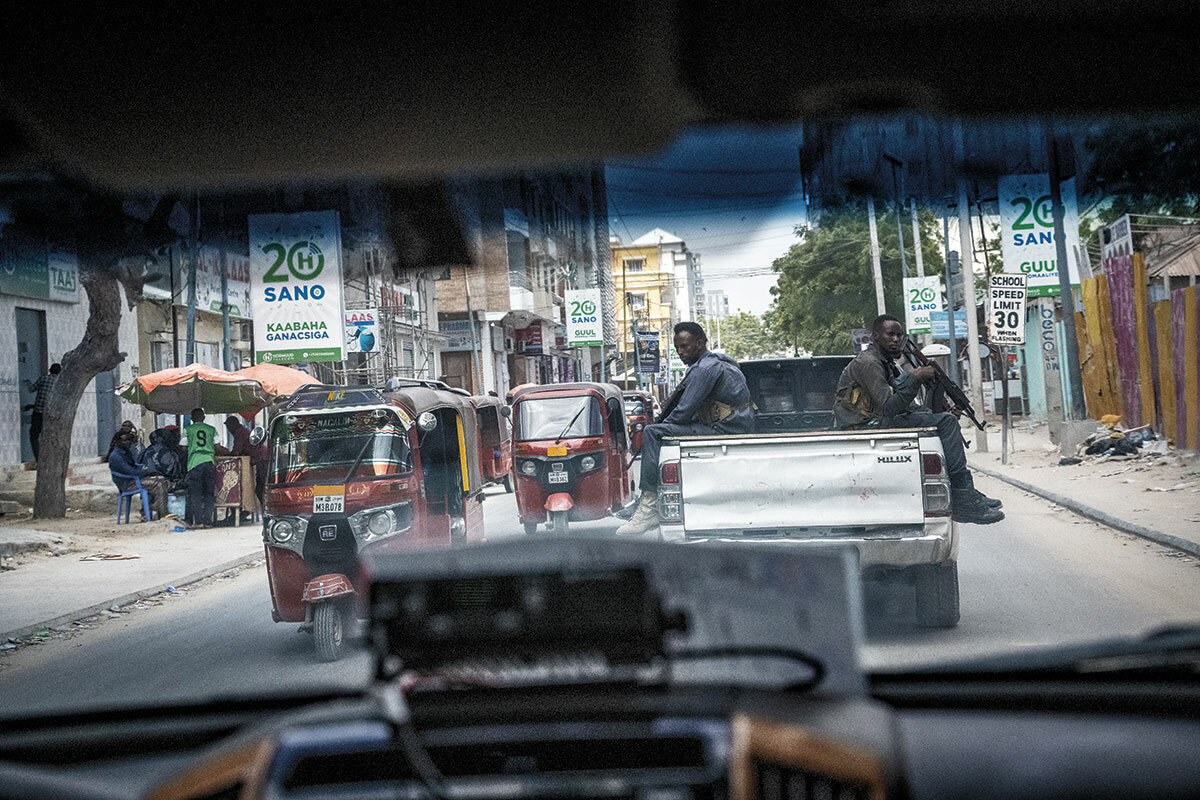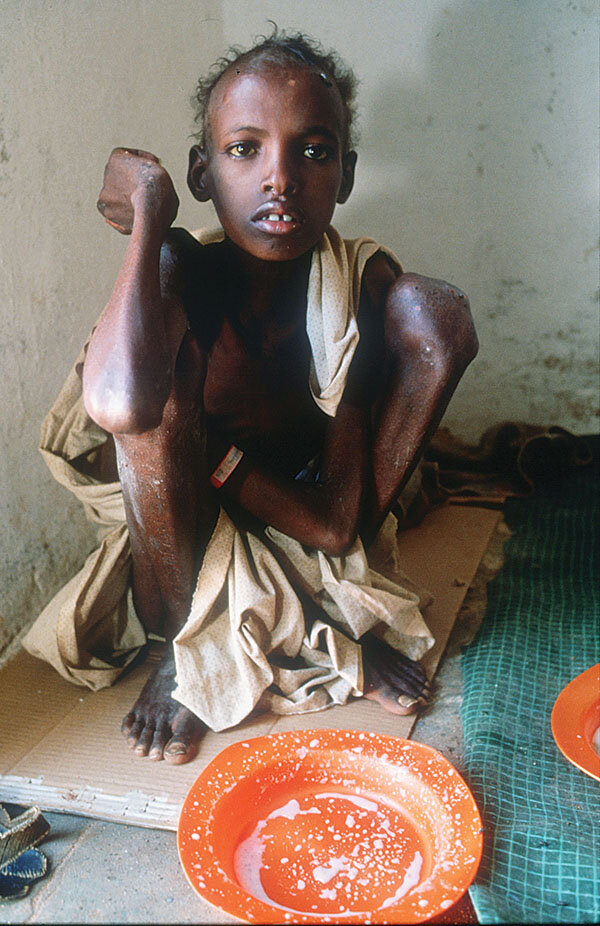Somalia’s peril and promise: A reporter returns after 30 years
Loading...
| MOGADISHU and BAIDOA, SOMALIA
The U.S. Navy SEALs were ready for battle on Dec. 9, 1992, leaping from their inflatable Zodiacs and wading through the warm Indian Ocean waters toward the Mogadishu airport beach. Coming ashore under a brilliant moon, their mission was clear: feed legions of starving Somalis and control the dual crises of hunger and chronic insecurity that had afflicted the country for more than a year.
It was a historic moment – one I witnessed up close that night, my boots sloshing and trousers soaked to the knees, as I jockeyed with other reporters tipped off by military brass to record the landing. Our TV lights and strobe flashes lit up the sand – and the tempers of the SEALs.
They were forced to dodge our unexpected phalanx instead of slipping into the night, their faces smeared in camouflage paint and bodies laden to buckling with gear and guns.
Why We Wrote This
A story focused onDecades of drought and famine, amplified by clan warfare and Islamist militants, have made safety elusive in Somalia. Yet progress toward greater stability persists.
It was a bizarre opening scene of what would become one of the most surreal military deployments in modern American history. Operation Restore Hope was billed as the first purely benevolent use of the strongest military ever created. And indeed, the American arrival did bring hope of disarmament, nourishment, and peace.
But over the next 15 months, the humanitarian effort – which then-President George H.W. Bush declared to be “God’s work” at which Americans “cannot fail” – devolved into a deeply flawed search that seared images of a great power’s humiliation into the American consciousness.
The famine was ultimately stemmed. But what loomed larger in memory was the infamous “Black Hawk Down” street battle that left 18 Americans and some 312 Somalis dead. Jubilant Somalis dragged the bodies of several fallen U.S. troops through the streets.
I made roughly 50 reporting trips to Somalia during that pivotal period of 1991 to 1994 from my base in Nairobi, Kenya. Thirty years later, I have come back to document – once again – an impending humanitarian crisis of famine, driven by drought and insecurity.
The threats sound alarmingly familiar. And yet, as I fly into a new Mogadishu airport, I immediately sense how much has changed from the country of shattered buildings, streets, and lives of my memory. In so many ways, Somalia today is unrecognizable.
On a Tuesday where the temperatures are hitting 32 degrees Celsius (90 degrees Fahrenheit), I see the change in the modern terminal that welcomes visitors like me flying in on Turkish, Ethiopian, and Qatari airlines. Gone is the gutted concrete hulk that was here when the Americans landed. Gone too is much of the beach where I photographed the Navy SEALs: Decades of erosion have washed away sand, and at low tide what remains is a moonscape of sharp limestone suitable only for starfish and limpets.
I see the effects of technology and modernization: Somalis bank and move cash using their mobile phones; they trade cryptocurrency; and Mogadishu – once a low-slung capital with crumbling architectural flourishes still visible from Italian colonial rule a century ago – is now defined by taller buildings and hotels.
And there is a government that functions. In late spring it mounted an ongoing offensive against the Al Qaeda-linked Islamist militants of Al Shabab, whose attacks continue in revenge for the unprecedented territorial gains made by the government after 15 years of battle.
The juxtaposition between past and present speaks to a country swirling with competing forces: a burgeoning humanitarian crisis due to the longest drought in 40 years, once again almost unimaginable in its scale – and the ever-present threat of Al Shabab, which targets civilians and the government alike, and has destroyed crops and water sources.
Yet today, the United Nations and Western relief agencies are far more aware of the hunger threat. And despite limited access – they do not work in areas controlled by Al Shabab – they know the needs and have the funding mechanisms in place to take the most lethal edge off the famine if action is taken right now.
And then there are people like Mohamed, an airport worker whose fascination with chess and expectations for the future clearly stretch far beyond the arrivals hall, where he helps speed the visa process and collects luggage. I suspect the events I witnessed, and Somalis endured, 30 years ago are today little more to Mohamed and his contemporaries than stories passed down by elders.
“You are from America?” he asks me, surprised to see an American here. For him it is an easy start to a conversation on a topic that would have hardly been on anyone’s mind three decades ago. Mohamed plays on Somalia’s national chess team, reels off the names of several American chess grandmasters, and settles on the young phenomenon Wesley So, who left the Philippines and now plays for the United States.
On his phone, among the multitude of diagrams of chess board problems and images of him playing a Slovenian opponent at a recent tournament, Mohamed has a picture of himself with the prodigy once ranked No. 2 in the world. As he waves goodbye to me, his job done, I am struck by the forward-looking sense of ambition that has rippled around me.
Thirty years ago, far different – and far more deadly – issues were on the minds of Somalis.
My reporting trips first focused on the expanding grip and impact of warlords who accumulated huge caches of weapons and jury-rigged key items such as battlewagons that we called “technicals” – land cruisers with their tops sheared off, mounted with anti-aircraft or anti-tank weapons.
In retrospect, I should have heard the alarm bells ringing in September 1991, when Somalia’s strongest warlord – Gen. Mohamed Farah Aidid – took me on a tour of his Mogadishu battlewagon workshops. General Aidid, as I wrote at the time, paused for a moment, and then his “lips curled in happiness” as he admired a cleverly converted air-to-air missile system stripped from a MiG-21 fighter plane.
“This has a very nice effective range,” the warlord said, as he rested his hand on the dull tin housing of the weapon.
After the ousting of President Mohamed Siad Barre in early 1991, the dictator’s vast arsenals fell into the hands of the clan warlords who had toppled him, with General Aidid the biggest beneficiary. After he was overthrown, Mr. Barre (nicknamed “Big Mouth” by his citizens) and his clan retreated southwest from Mogadishu, pillaging and destroying the food stores of the clans that had ended their rule. That set in motion conditions for a famine that, combined with severe drought, would kill as many as 300,000 Somalis.
Back then, power and protection came only from the tip of a gun. Insecurity and looting became so severe that everything became a target, from lengths of copper cable dug up from beneath the streets to sacks of grain from Western donors. In one case, 8,000 tons of food was stolen from a port warehouse in what relief workers pithily dubbed “spontaneous distribution.”
Nothing was sacred. Even the body of the Italian bishop of Mogadishu – the first foreigner murdered in 1989, as Mr. Barre’s security services began to lose control – was exhumed by gunmen who stole his gold fillings.
The epicenter of affliction was Baidoa, where I and a couple of colleagues again met General Aidid in June 1992. He greeted us on the airport tarmac, sporting a flower-print shirt and a gray hat cocked jauntily to one side, totems that belied his ruthlessness. He declared that he had vanquished Mr. Barre’s forces. The warlord promised “no more fighting,” and vowed that the hungry could now be fed.
For me, the question had loomed large about the extent of the hunger confronting Somalis.
The answer only became clear when we broke away from General Aidid’s compound and physically forced our way into a Red Cross feeding center nearby. The metal gate was blocked by men fighting to get in for food, while armed guards beat them back with their guns.
Inside, we were confronted by horrific images of starvation that would soon haunt the rest of the world.
After several years reporting from war zones and regions of extreme destitution, I was familiar with depictions of despair. Even so, I was shocked: Emaciated children, wearing soiled rags or naked, sat on the gravelly ground in rows, strangely quiet because of the empty pit in their stomachs. The “kitchen” had just opened and would minister to this sea of 1,000 starving Somalis.
It was clear even then why Baidoa would soon be known as the “City of the Death,” where the toll would reach 1,700 per day. We were at that feeding center less than 30 minutes before getting kicked out. My shock was so great that I did not waste time taking notes, and instead shot seven rolls of film – 252 images, or one frame every seven seconds.
Today, Baidoa is once again the epicenter of a crisis that defies the imagination. The U.N. projects that 1.8 million children alone are at risk of acute malnutrition, and that nearly half of Somalia’s estimated 17 million people face “acute food shortages” without immediate help.
The U.N. is now warning of an “unprecedented” sixth rainy season with below-average rainfall, and projects famine between April and June in some areas. Combined with constant conflict, the scenes of deprivation in the 500 settlements that ring Baidoa, with their primitive stick-and-rag shelters and the occasional piece of plastic sheeting, are identical to those that emerged 30 years ago.
So, too, are those in the hospitals and emergency feeding centers of Baidoa and Mogadishu; my photographs today of mothers administering paste or gruel to severely malnourished children match those I took in 1992.
Relief workers and the U.N. are aware of the comparisons and the sense of déjà vu – especially when it comes to asking for urgent donations. Though the Ukraine war has caused European and U.K. aid to shrivel, the U.S. has nearly doubled its funding for food to $888 million in 2022, according to U.N. figures.
“In 1991 we were talking about an emergency. Then today, after more than 30 years, we are talking about the same emergency – so there is donor fatigue,” says Ahmed Ali Issack, head of the Concern Worldwide office in Baidoa. “Someone funding in 1991 is funding the same activities now – these are some of the challenges.”
Witness to both eras is Abdullahi Ali Watiin, the mayor of Baidoa, whose city has been surrounded by Al Shabab for 12 years.
He was just a boy when hunger forced his family to flee Baidoa for the village of Wariiri, 30 miles to the north, where his father had a farm. As famine gripped the area, they moved farther away, to Mogadishu. The family returned to their village after nine months away.
Losses were incomprehensible.
“When I came back, I realized that all the people I knew in that village all died from the famine,” says Mr. Watiin, speaking to me in the Baidoa mayor’s office, a posse of his heavily armed security guards just outside.
“All of them,” he underscores. “If they had 10 children, eight of them died, and the mother and father died. Everybody died. Every day I saw dying people in front of me; I would try to help them, but they could not swallow. ... It was a very hard time.”
Little did we know, that bright night on the Mogadishu beach in late 1992, how consequential the American and U.N. military intervention would be – though ultimately for all the wrong reasons. In just over a year, it would be over, after U.S. commanders turned the humanitarian mission into a violent confrontation with General Aidid that included a manhunt and even a Wild West-style “Wanted” poster. Somalis were offered $25,000 to capture the warlord and “bring him to the U.N., Gate 8.”
Along the way, the term “peacekeeping” – the original task of both the U.S. and U.N. forces – would give way to the concept of “peace enforcement,” in which a Chapter VII U.N. mandate that allowed foreign forces to engage in battle was fully exercised.
History records the unhappy outcome. The standoff included numerous battles, with the manhunt alone resulting in a death toll of an estimated 2,000 Somalis, 30 American soldiers, dozens of Pakistani U.N. blue helmets, and a handful of relief workers and journalists.
For four nights in June 1993, in fact, American aircraft targeted General Aidid’s compound with airstrikes, and each morning at dawn, we journalists would visit the scene to see the result.
One of those days, as debris in the background smoldered, several Somali women held up a dud 105 mm shell fired from a U.S. Spectre gunship, which had only partly burst into shrapnel. They presented it to me as “evidence” of what they called war crimes – and today it still sits on my desk in London, a reminder of their anger.
The turning point for Somalis came on July 12, 1993, when, in a bid to marginalize the warlord, American forces deployed Cobra helicopters to attack a meeting held by General Aidid’s clan. The Americans killed more than 50 Somalis. I watched from the roof of my nearby hotel, then jumped in the car with my driver and interpreter.
The attack pulverized the house with 16 TOW anti-tank missiles and 2,020 rounds of 20 mm cannon fire. The operation was just 17 minutes long, and I arrived at minute 15, at a sandy crossroads where American snipers were keeping crowds of angry Somalis at bay down three separate roads.
Their warning to me to stay away came instantly – as did their sudden departure. I became engulfed by a vengeful and knife-wielding Somali mob, coming from three sides. They had just seen their fathers, sons, and grandfathers die in a fusillade of U.N.-sanctioned violence – and thought that I had been left behind by the killers.
I was clubbed and pummeled by the churning crowd. As I fended off an 18-inch blade brandished toward my face, a machete crashed into the back of my head. And then, amid this melee ... a flash of compassion.
“A Somali man hugged me, his tears soaking through my T-shirt into my thin Kevlar flak jacket, and I was sure he was going to knife me, his arms locked around me and hands behind,” I wrote afterward. “But he showed mercy ... and he disentangled me for a split second from the crowd and there was hope.”
I barely escaped, wounded and bleeding, but was able to warn colleagues back at the hotel to take far greater care than usual. Unlike any previous U.S. attack, this one triggered a visceral response that surprised many Somalis. The blade-wielding mob would later kill four fellow journalists.
The turning point for the Americans came on Oct. 3-4, with the “Black Hawk Down” raid in Mogadishu, during which two American helicopters were shot down. Multiple Somali ambushes and a 16-hour gunbattle left a superpower humiliated by what appeared to be no more than a ragtag bunch of clan gunmen wearing flip-flops.
By then, the Somali desire for revenge against the U.S. was so widespread that even gunmen from clans fiercely opposed to General Aidid crossed the so-called Green Line to join that anti-U.S. fight, filling up hospitals back in their own clans’ turf with wounded Somalis.
That battle triggered U.S. President Bill Clinton’s order to withdraw from Somalia. Its impact was far broader, however: It also complicated the American response to the war in Bosnia, and caused it to delay action – and even to veto independent U.N. action – that could have slowed the 1994 genocide in Rwanda.
Adding insult, a report commissioned by the U.S. government found that the American military intervention may have saved 10,000 to 25,000 people (plus 40,000 during an August to December 1992 airlift of relief food). But it also determined that the number of lives lost “due to delays in undertaking earlier decisive action” was between 100,000 and 125,000.
Anger could not have been more palpable among Somalis, who could not understand how their would-be saviors had become a new enemy.
“Americans will not be safe from assassination, or even able to walk the streets of Somalia for 20 years,” I was warned by a British man, who had spent time in Somalia many years earlier and had personal experience here of long-delayed retribution. “They’ve just killed too many people.”
Three decades later, I am reminded of his words as I again travel the roads of Mogadishu and Baidoa, sealed in an armored vehicle that is protected by anxious Somali security guards. He was right – but not because of any lingering anti-American sentiment.
It is the presence of Al Shabab and the militants’ use of devastating suicide car and truck bombs, roadside explosive devices, and targeted assassinations that cause all foreigners – including the few Americans in the country – to move only in convoys bristling with assault rifles.
My field of vision, from the back seat, is limited to the view through the windshield and side windows, their mirrored glass masking the vehicle’s occupants. Tactical radios clamor and crackle. When we can go out – unsealing the heavy doors to step into the heat, dust, and often fetid air of a camp or a hospital – visits are limited to half an hour, to prevent Al Shabab agents from having enough time to mount an attack or a kidnapping.
President Hassan Sheikh Mohamud has declared “total war” against Al Shabab, and an offensive by the Somali National Army, started late last spring and increasingly joined by local clan militia, has put the Islamists on the defensive – a far cry from the warlord-driven anarchy of three decades ago.
In this fight against Al Shabab, most Somalis welcome the small American military presence, which trains the Danab, or Lightning, as Somali special forces units are known. American air and drone strikes have also been instrumental in blunting Al Shabab counterattacks.
As I travel, there is little trace of the U.S. legacy I once documented: 28 mobile clinics that treated 5,000 Somalis, 600 miles of rehabilitated roads, some donated school supplies, a few school buildings built, and orphanages opened and provided with American-supplied food.
All remnants of the downed Black Hawk helicopters have disappeared, and the buildings targeted by U.S. forces back then have been razed, rebuilt, and transformed.
Still, I wanted to find someone burned into my memory since late 1992. I had never forgotten Ibrahim Ali Mohamed, a severely malnourished boy I photographed in Baidoa as part of Time magazine’s Man of the Year issue. President Clinton won that title, but the child was chosen to “symbolize Somalia’s anguish.” Hunkered down over an orange plastic bowl at a UNICEF feeding center, Ibrahim stared at my camera, his bony frame protruding from taut skin, his eyes focused but listless.
I hoped to find Ibrahim in Baidoa, if he was still alive. There was indeed still a UNICEF compound in town – its high walls crowned with multiple coils of razor wire – with the same name as the feeding center, Isha. That’s where Ibrahim once spent his days curled up on the concrete floor in a room for orphans.
My search didn’t yield results, but it did shed light on what was the likely fate of many of the children I met three decades earlier. “Eighty percent, he’s either killed, or doing the killing [as a member of Al Shabab],” surmised Abdiqani Maalim, a staffer for Concern Worldwide in Baidoa. “Many of these guys [orphaned famine survivors] joined armed groups just to survive.”
That is a lethal cycle that many Somalis today are trying to break. One generation after Somalia’s extreme hunger and violence first drew comparisons to the fabled Four Horsemen of the Apocalypse, hospitals provide skilled treatment for displaced people, while new mothers attend classes to learn about breastfeeding. And while children are dying again of hunger, officials say fewer are losing their lives because of better information – and greater ability to address the needs.
The rhythm of life these days includes a local ministry official in Baidoa asking a commercial plane to briefly divert its route to allow him to review troops fighting Al Shabab. It includes the scene in the small airport waiting room, where one Somali passenger uses the Binance app to trade cryptocurrency. It features the young man with an easy smile making tea for customers and asking me if I have change for a $50 bill – a note so soiled it appears to have crossed Somali deserts repeatedly, tucked between a camel saddle and a sweating, ornery beast.
Even so, experts are weighing whether Somalia’s current crisis should be called a “famine” – as in 1992 and 2011 – and conflict still reigns in many areas. Al Shabab explosions can strike at any time, and Somalia is still widely seen in the region as a country beset by economic and security obstacles.
It is a dichotomy Somalis like Fatima confront daily. She graduated with a bachelor’s degree in public administration, is writing a book about the challenges of living in Mogadishu, and works as a receptionist in a fortresslike hotel. It is a relatively safe and promising job.
Nonetheless, she must venture onto dangerous streets to get to work. “We still have to tell our families ‘goodbye’ in the morning,” says Fatima, “because we don’t know if we will come back.”






